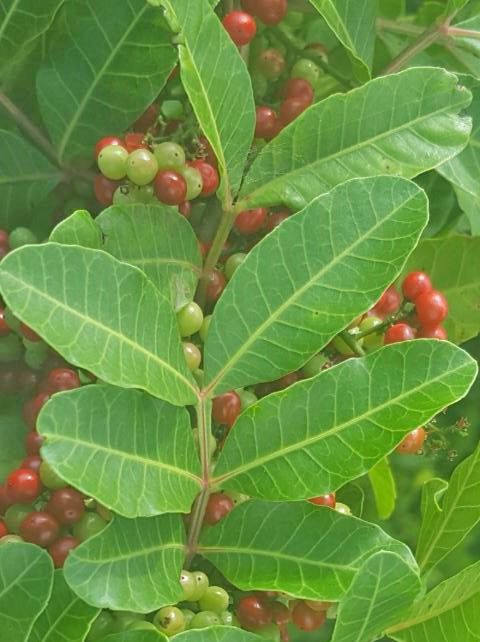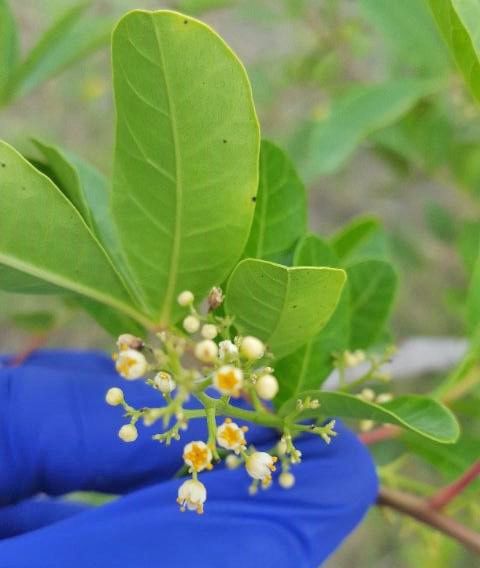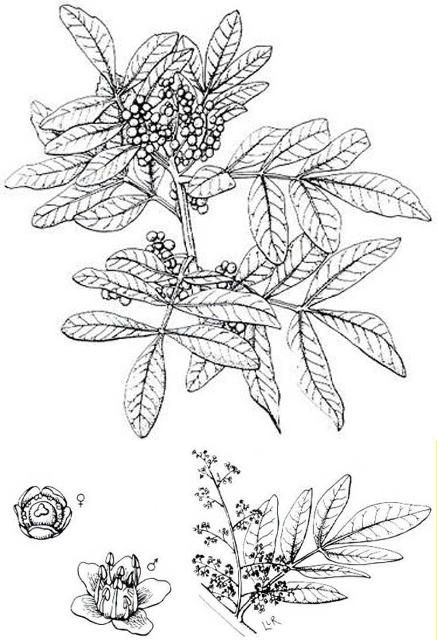Brazilian Peppertree Control
Common Name: Brazilian peppertree
Scientific Name: Schinus terebinthifolia
Family Name: Anacardiaceae (cashew or sumac family)
Introduction
This publication presents management recommendations for Schinus terebinthifolia, the Brazilian peppertree. It contains information about Brazilian peppertree biology, herbicide application techniques, and the status of biological control. The intended audience includes homeowners and land managers primarily in coastal areas of central and south Florida where Brazilian peppertree is prevalent.
General Background
Many invasive species are harming Florida's natural ecosystems. Brazilian peppertree is one of the worst offenders (Cuda et al. 2006). This plant is encroaching upon nearly all terrestrial ecosystems in central and south Florida and has recently been found in Okaloosa County in the Florida Panhandle. Brazilian peppertree is the most widely distributed and abundant invasive species in the Florida Everglades, occupying 30,379 ha (Rodgers, Pernas, and Hill 2014). Brazilian peppertree is native to Brazil, Argentina, and Paraguay (Langeland et al 2008). It is thought to have been introduced to Florida in the 1840s as an ornamental plant (Figure 1) (Barkley 1944).

Credit: C. Minteer, UF/IFAS
UF/IFAS Assessment of Brazilian Peppertree
The UF/IFAS Assessment of Non-Native Plants in Florida’s Natural Areas is a research-based source of information. The UF/IFAS Assessment for Brazilian peppertree can be accessed online at https://assessment.ifas.ufl.edu/assessments/schinus-terebinthifolia/. Brazilian peppertree is listed on Florida’s Noxious Weed List. Inclusion on this regulatory list means "it is unlawful to introduce, multiply, possess, move or release any noxious weed" without a permit in the state of Florida (FDACS 2019a). FDACS defines a noxious weed as:
"Any living stage of a parasitic or other plant which may be a serious agricultural threat in Florida; have a negative impact on endangered, threatened, or commercially exploited plant species; or if the plant is a naturalized plant that disrupts naturally occurring native plant communities" (FDACS 2019b).
The Florida Department of Agriculture and Consumer Services (FDACS) oversees this list (including the addition of new species and exemptions for agronomic and horticultural cultivars of listed species). The FDACS Division of Plant Industry (DPI) enforces regulations (inspections and fines) (Lieurance and Gettys 2019). The full list is online at https://www.flrules.org/gateway/ruleNo.asp?id=5B-57.007.
Habitat
Brazilian peppertree is sensitive to cold temperatures, so it is more abundant in south and coastal Florida and protected areas of central and north Florida. Brazilian peppertree colonizes native communities such as pastures, urban landscapes, pine rocklands, coastal dunes, and more. It has also colonized the margins of roads, rights of way, levees, and canals throughout south and central Florida.
Identification
The cotyledons (embryonic leaves) are simple; both the apex and the base have an obtuse outline. The margin is generally curved inward on one side. The first true leaves are simple with a toothed margin (Figure 2). The later leaves are compound.

Credit: UF/IFAS Center for Aquatic and Invasive Plants
Mature Plant
Brazilian peppertree is a shrub or small tree that grows to 10 m (33 ft) tall with a short trunk which is usually hidden in a dense head of contorted, intertwining branches. The leaves have a reddish and sometimes winged midrib (Figure 3), and three to 13 sessile, oblong or elliptic, finely toothed leaflets, 2.5 to 5 cm (1 to 2 in) long. Leaves smell of turpentine when crushed. The plants are either male and have male flowers (with pollen) or female with flowers that do not produce pollen (Figure 5). The male and female flowers are white (Figure 4) and consist of five parts with male flowers having 10 stamens in two rows of five (Figure 5). Petals are 1.5 mm (0.6 in) long. The male flowers also have a lobed disc within the stamens. The fruits are found on female plants in clusters. These fruits are glossy, green, and juicy at first. They become bright red upon ripening and grow to 6 mm (2.4 in) wide. The mature fruit is a small, bright red, spherical drupe (Langeland et al. 2008). Seeds measure 0.3 mm in diameter and are dark brown in color (UF/IFAS Center for Aquatic and Invasive Plants 2018).

Credit: C. Minteer, UF/IFAS

Credit: C. Minteer, UF/IFAS

Credit: UF/IFAS Center for Aquatic and Invasive Plants
Biology
Flowering occurs predominantly from September through November in Florida. Fruits are usually mature by December. Birds and mammals are the primary means of seed dispersal. The removal of the pulp around the seed by the digestive tract of birds increases the seed's germination rate (Dlamini, Zachariades, and Downs 2018). Brazilian peppertree's high seed viability combined with animal dispersal may help explain widespread colonization.
Chemical Control
Using Herbicides
Herbicides that aid in the control of Brazilian peppertrees are available (Table 1). Only herbicides recommended for Brazilian peppertree control should be used. Read the label carefully and follow the instructions; it is illegal to use an herbicide in a manner inconsistent with the label's instructions. For more information on the individual plant treatments listed below, see EDIS publication SS-AGR-260, Herbicide Application Techniques for Woody Plant Control (https://edis.ifas.ufl.edu/ag245).
Cut Stump Application
Cutting down Brazilian peppertrees and treating the tops of the stumps with herbicide comprise one method of control. A saw should be used to cut the trunk as close to the ground as possible. Within five minutes, an herbicide containing the active ingredient glyphosate or triclopyr should be applied carefully to the thin layer of living tissue, called the cambium, which is just inside the bark of the stump.
The best time to cut Brazilian peppertrees is when they are not fruiting. Seeds in the fruits can produce new Brazilian peppertrees. If fruiting Brazilian peppertrees are cut, care should be taken not to spread the fruits to locations where they might become established.
Caution: Brazilian peppertree produces a sap that may result in contact dermatitis in some people. When cutting trees, avoid the sap if possible. Individuals who are highly sensitive to the sap may also be affected by touching the leaves. Use proper protective gear when cutting the tree and applying the herbicides.
Basal Bark Herbicide Application
Brazilian peppertrees can be controlled using basal bark herbicide application. In this method, an application of an oil-soluble herbicide product such as triclopyr ester is applied in an oil carrier to the lower part of the trunk in a 12- to 18-inch band around the circumference of the tree. It may take several weeks before the herbicide's effects become apparent. Complete defoliation, a lack of new shoots, and the presence of termites are indicators that the treatment has been successful.
Basal bark treatments are most effective in the fall when Brazilian peppertrees are flowering due to the high level of translocation occurring within the trees. Fruiting occurs during winter, and Brazilian peppertrees that have been treated using a basal bark application may retain their fruit. The herbicide will move downward to the roots with the sap flow. In this situation, the area will need to be checked for seedlings on a regular basis.
Foliar Herbicide Application
Foliar herbicide application can be used on Brazilian peppertree seedlings and saplings. An herbicide containing triclopyr or glyphosate is applied directly to the foliage. Spray to wet, but not to the point of runoff. Good coverage is essential. Although both herbicides translocate throughout the plant, coverage on only one side of a tree with glyphosate or triclopyr will not completely kill it. Keep in mind that foliar applications require considerably more herbicide to control Brazilian peppertree. Take precautions to prevent herbicide drift injury to nearby plants.
Biological Control
For biological control agents to be approved for release in Florida, scientists must show that those agents are specific to Brazilian peppertree. Two species have been approved for release in Florida: one thrips species and one species of leaf-galling insects in the family Calophyidae. Both the thrips and the leaf gallers feed on new shoots. Releases of the thrips species, Pseudophilothrips ichini, began in Florida in June 2019. A multiagency group of scientists from UF/IFAS, USDA-ARS, and the Florida Department of Agriculture and Consumer Services Division of Plant Industry are working to rear and release insects on the Florida landscape. The leaf galler, Calophya latiforceps, has not yet been released due to rearing difficulties, but will likely be released in 2022. Both of these species are host-specific to Brazilian peppertree and have been shown to damage the plant in laboratory studies (Prade et al. 2016; Manrique et al. 2014).
For more information, consult the following EDIS publications:
EENY689: Yellow Brazilian Pepper-Tree Leaf Galler (Suggested Common Name) Calophya latiforceps Burckhardt (Insecta: Hemiptera: Calophyidae: Calophyinae)—https://edis.ifas.ufl.edu/in1186
ENY-820: Classical Biological Control of Brazilian Peppertree (Schinus terebinthifolia) in Florida—https://edis.ifas.ufl.edu/in114
EENY270: Brazilian Peppertree Seed Wasp, Megastigmus transvaalensis (Hymenoptera: Torymidae)—https://edis.ifas.ufl.edu/in453
ENY-737: Brazilian Peppertree Thrips Pseudophilothrips ichini (Hood) (Insecta: Thysanoptera: Phlaeothripidae)—https://edis.ifas.ufl.edu/publication/in1270
References
Barkley, F. A. 1944. Schinus L. Brittonia 5:160–98.
Cuda, J. P., A. P. Ferriter, V. Manrique, and J. C. Medal. 2006. Florida's Brazilian Peppertree Management Plan: Recommendations from the Brazilian Peppertree Task Force, 2nd Edition. Florida Exotic Pest Plant Council. http://www.fleppc.org/Manage_Plans/2006BPmanagePlan5.pdf
Dlamini, P., C. Zachariades, and C. Downs. 2018. "The Effect of Frugivorous Birds on Seed Dispersal and Germination of the Invasive Brazilian Pepper Tree (Schinus terebinthifolius) and Indian Laurel (Litsea glutinosa)." S. Afr. J. Bot. 114:61–8.
Langeland, K. A., H. M. Cherry, C. M. McCormick, and K. A. Craddock Burks. 2008. Identification & Biology of Non-Native Plants in Florida's Natural Areas, 2nd Edition. Gainesville, FL: University of Florida Institute of Food and Agricultural Sciences. Lieurance, D., and L. A. Gettys. 2019. Lost in the Weeds? A Comprehensive Guide to Florida’s Many Non-Native Plant Lists. SS-AGR-436. Gainesville: University of Florida Institute of Food and Agricultural Sciences. https://edis.ifas.ufl.edu/publication/AG436
Manrique, V., R. Diaz, L. Erazo, N. Reddi, G. S. Wheeler, D. Williams, and W. A. Overholt. 2014. "Comparison of Two Populations of Pseudophilothrips ichini (Thysanoptera: Phlaeothripidae) As Candidates for Biological Control of the Invasive Weed Schinus terebinthifolia (Sapindales: Anacardiaceae)." Biocontrol Sci. Technol. 24:518–35.
Prade, P., R. Diaz, M. D. Vitorino, J. P. Cuda, P. Kumar, B. Gruber, and W. A. Overholt. 2016. "Galls Induced by Calophya latiforceps (Hemiptera: Calophyidae) Reduce Leaf Performance and Growth of Brazilian Peppertree." Biocontrol Sci. Technol. 26:23–34.
Rodgers, L., T. Pernas, and S. D. Hill. 2014. "Mapping Invasive Plant Distributions in the Florida Everglades Using the Digital Aerial Sketch Mapping Technique." Invasive Plant Science and Management 7:360–74.
UF/IFAS Center for Aquatic and Invasive Plants. 2018. "Schinus terebinthifolia." Plant Directory. Accessed on October 31, 2018. https://plants.ifas.ufl.edu/plant-directory/schinus-terebinthifolia/#desc
Wunderlin, R. P., B. F. Hansen, A. R. Franck, and F. B. Essig. 2021. Atlas of Florida Plants (http://florida.plantatlas.usf.edu/). [S. M. Landry and K. N. Campbell (application development), USF Water Institute.] Institute for Systematic Botany, University of South Florida, Tampa.
Table 1. Herbicides and application methods for Brazilian peppertree control.


